Back in November 2023, Heather Upfield from Kilwinning Heritage, was in correspondence with Bob Farace from Clinton, Connecticut, USA about a painting relating to Kilwinning. In December 2023, she was in correspondence with Brett Hamm from Leduc, Alberta, Canada, about a Kilwinning-made James Blair longcase clock. Both have ancestors in Kilwinning and Dalry, and in the excitement of the post New Year rush, Heather uncovered an extraordinary coincidence linking the two! Read about it here.
1. Painted Sign: The Hugh Montgomerie, 12th Earl of Eglinton (1739-1819) now in Clinton, Connecticut, USA
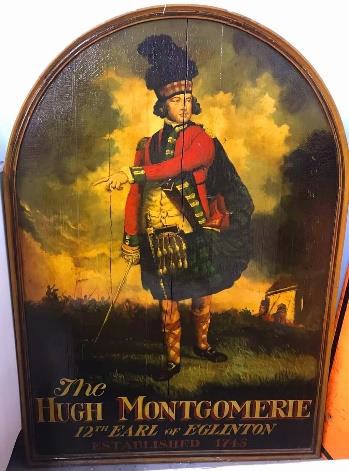
Recently, this image appeared in a post in a Facebook ‘All Things Scottish’ group. It is a sign of some sort, with a reasonable copy of John Singleton Copley’s c1780 painting of the 12th Earl of Eglinton, in 77th Highlander battle dress, after a victory in America. The sign was, then, clearly produced after 1780.
Fascinated to know more about it, I contacted the sender on Messenger to ask about its history.
I had an immediate reply from Bob Farace, in Clinton, Connecticut, USA. He told me that some of his ancestors are from Dalry and others from Broomhill Farm in Kilwinning. His genealogy research had highlighted the significance of the Earls of Eglinton throughout the Lands of Cunninghame (now modern-day North Ayrshire).
When he found this wooden painted sign in a Clinton antique shop, he knew he had to have it! The sign is shrouded in mystery; he has no idea where it came from or whether it was an inn sign or relates to some other premises. An inscription at the bottom of the painting states “Established 1745”, which indicates it was a business.
Eventually, he and some of his mates chipped in to buy it. At Christmas 2022, it was presented to Dave Robertson (a native Glaswegian who relocated to the US) the owner and founder of Scottish Dave’s Pub in Clinton. Dave admits to having visited Kilwinning several times!
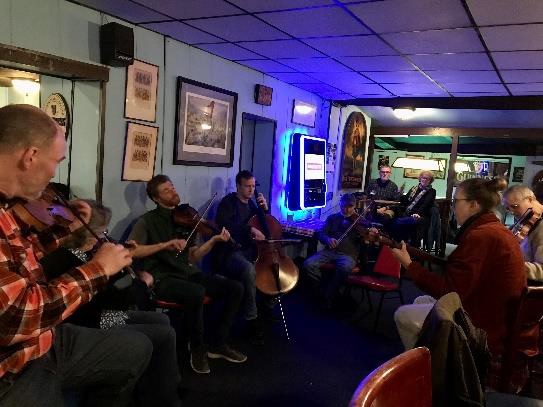
The sign now hangs on the wall overlooking the bar. And judging by a photo Bob sent me, Scottish Dave’s Pub looks like a fun place to be.
Music Night shows the painted sign, measuring 48”x34”, on the wall, beyond the illuminated screen. A Kilwinning Heritage field visit is required!
I have made a number of contacts from abroad in connection with Kilwinning Heritage and in some instances, I am happy to help correspondents with some simple genealogy research.
In the case of Bob’s Broomhill Farm ancestors, I was able to pinpoint exactly where the farm is, there being two Broomhill Farms in Kilwinning. One out towards Montgreenan, and the other to the south west of Monkcastle in the hills above Dalgarven. It was the latter farm that was owned by Bob’s William Donald ancestors, known to have lived there at least since 1815 and known to be still occupying the land in the mid 19th century, possibly longer.
Amazingly, Jeni Park, who heads the team curating Kilwinning Heritage’s ‘Frew Collection’, found a William Donald of Broomhill document relating to a Codicil of a Will, dated 13 April 1857, amongst the thousands of documents so far processed!
2. James Blair longcase clock, Stonewall, Province of Manitoba, Canada
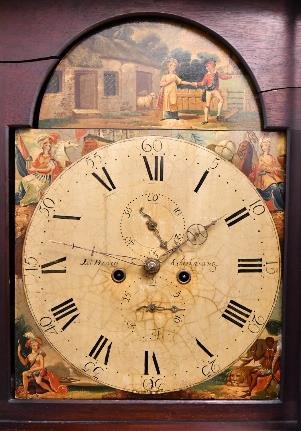
Shortly before Christmas 2023, Kilwinning Heritage was contacted by Brett Hamm from Leduc, in Alberta, Canada. He explained that around ten years ago, his Mother, Sandra Hamm (née Steel), in Stonewall, Manitoba, had been given a James Blair, Kilwinning longcase clock, by her parents; an heirloom that had been in the family for generations.
Looking for information about the clock maker, Brett had initially found my Blog ‘The Clock and Watchmakers of Kilwinning’, published 5 November 2021, on The Antiquarian Horological Society website www.ahsoc.org/blog/the-clock-and-watchmakers-of-kilwinning/. This article pointed him to Kilwinning Heritage, and from thence to me. I was more than happy to talk clocks!
Brett revealed that the clock had been purchased by Sandra and Brett’s Steel ancestors from Kilwinning, in the 1820s-1830s. They would almost certainly have known James Blair.
It eventually found its way to Glasgow in the latter part of the 19thC, with a later generation. When members of the Glasgow family, John and Catherine Steel (known familiarly as Ian and Rena) and their daughters Sandra and Anne, emigrated to Kelowna in British Columbia, in 1967, they took the clock with them. And that is where it had been until around 2014.
The clock is a beauty, though now weathered. The four corners illustrate The Four Continents: Europe, Asia, America and Africa, though Europe is clearly Britain, as the aft of a sailing ship is flying the Red Ensign of the British Merchant Navy. It is not uncommon for Four Continents illustrations, to just feature Britain in the Europe section! The illustration in the arch shows a pair of lovers at a cottage, with sheep.
The signature across the centre of the dial reads JAS BLAIR Kilwinning.
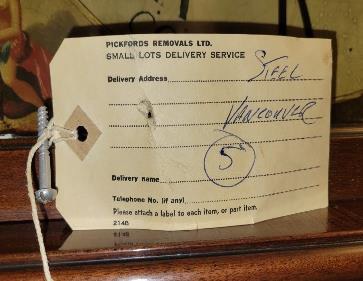
When Brett inspected the clock over the Christmas period, he discovered an original Shipping Tag inside the clock, bearing the destination ‘Vancouver’. The clock was originally shipped there and on arrival it was transported by road to Kelowna, around 280 miles away. This is where John (Ian), Catherine (Rena) and their daughters had settled. Brett also found a sheet glued over a side panel of the case from a trade journal, advertising exhibitors at the Glasgow International Exhibition of 1901. I like to think that his Glasgow ancestors visited the exhibition themselves!
3. And then things got interesting!
I am currently researching the Blacksmiths of Kilwinning for Kilwinning Heritage and I was delighted when Brett pointed out that one of his Steel ancestors had been a blacksmith at Dalgarven in the 19th century!
I was more than happy to do some digging into this branch of the Steel family, as it fed right into my research. I was also able to pinpoint the smithy on various maps.
The Kilwinning Census of 1851 shows John Steel, aged 32, Dalgarven Blacksmith and employer of 1 man, with his wife Catherine (nee Guy), and eldest son James. He also appears in the Kilwinning Census of 1861, still Dalgarven Blacksmith and employer of 1 man, but with two further children, John and Margaret, and his father-in-law, Neil Guy.
4. An extraordinary coincidence!
I very soon realized that John Steel’s Dalgarven Smithy (Brett and Sandra’s ancestor) is close to William Donald’s Broomhill Farm (Bob Farace’s ancestor).
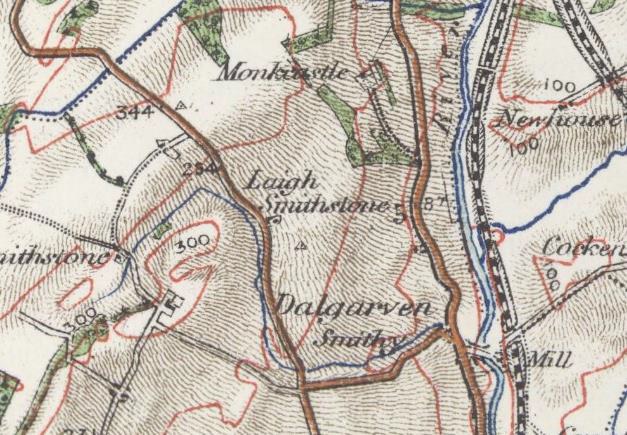
This map of 1856-1866 (revised, published 1912) shows Dalgarven Mill to the right of the River Garnock and Dalgarven Smithy on a lane to the left of what is now the A737.
Beyond the Smithy, turning right onto another lane, lies Laigh Smithstone Farm. Above this farm, is a track to the left, which shows two buildings above the contour line marked 254. This is Broomhill Farm, south west of Monkcastle.
I then recalled that not only was John Steel in the Kilwinning Census of 1851, but Bob had told me that his great-grandfather William Donald, was listed in the Kilwinning Census of 1851 too!
I had a Eureka! moment when I joined the dots and realized that William Donald and John Steel would have known each other! In the first place, there was only a mile between the Farm and the Smithy and in remote rural environments, everyone knows everyone else. I’m sure that a scandal involving William Donald’s son Robert, and his dalliance with the dairymaid, was the talk of the village!
However, more importantly, William Donald would have used working horses on the farm, both for ploughing and for carting corn to Dalgarven Mill for grinding. There is absolutely no doubt in my mind, that either William Donald took his horses to John Steel’s smithy, or John walked up to Broomhill, back in the mid 19th century, for shoeing and farrier work.
A field visit was called for and I recently headed up to Dalgarven. I was pleased to locate Broomhill Farm above Laigh Smithstone and to identify the original Steel family Smithy in Dalgarven Village. It is now converted into a residence. Robert Ferguson of Dalgarven Mill, confirmed the smithy building adding that the blacksmith’s family would have lived in the adjoining cottage.
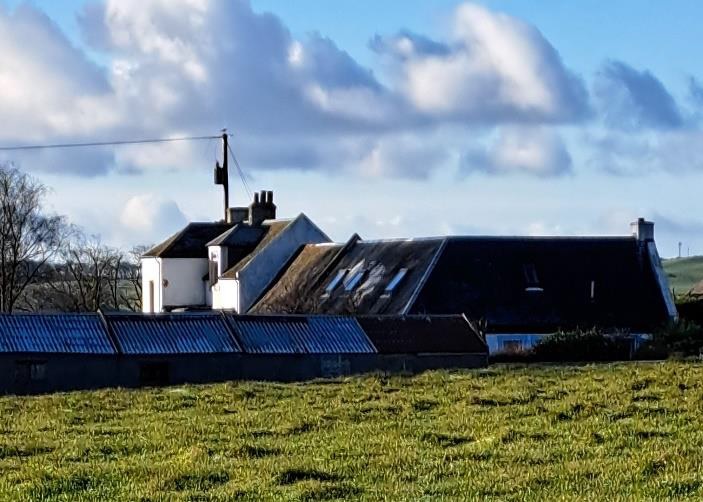
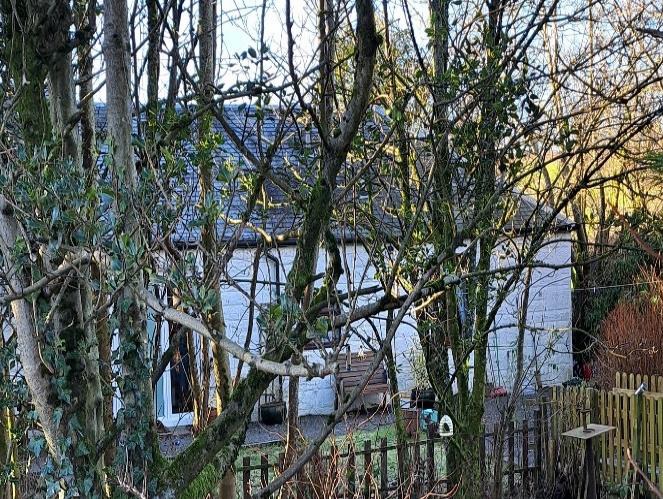
I have visions of William Donald and John Steel having a blether at the forge; of giving a wave in passing; or of their wives getting together to walk to church. I have notified Bob in USA, and Brett and Sandra in Canada of these findings, and they are all pleased to have their ancestors’ lives filled out and given depth and colour, when till now they have just been names on old records.
It was a lovely experience, finding out more about Kilwinning and its environs, and the people who lived there. I’m happy to have put these extraordinary links together, but what are the odds of doing two random pieces of research, at the same time, from two random families across the Pond, and finding their ancestors knew each other? It’s been an exciting journey!
Sandra Hamm told me that her parents, John (Ian) and Catherine (Rena) Steel from Kelowna, would have loved to have learned so much about their Kilwinning heritage, but sadly both passed away, in their 90s, in 2021 and 2022.
ACKNOWLEDGEMENTS
Bob Farace, USA & Brett and Sandra Hamm, Canada for sharing their stories
Jeni Park, for searching The Frew Collection, Kilwinning Heritage
Robert Ferguson, Museum of Ayrshire Country Life & Costume, for background information www.dalgarvenmill.org.uk
Angela and Toby Churchill for driving me around Dalgarven and Broomhill
Map: CC-BY, National Library of Scotland maps.nls.uk/index.html
Heather Upfield is a member of Kilwinning Heritage www.kilwinningheritage.org.uk/ and The Antiquarian Horological Society
© Heather Upfield, Kilwinning, 21 January 2024
